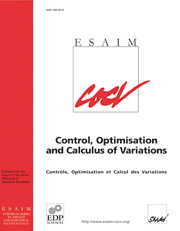Crossref Citations
This article has been cited by the following publications. This list is generated based on data provided by
Crossref.
Rao, Zhiping
and
Zidani, Hasnaa
2013.
Control and Optimization with PDE Constraints.
Vol. 164,
Issue. ,
p.
93.
Forcadel, Nicolas
and
Rao, Zhiping
2014.
Singular Perturbation of Optimal Control Problems on MultiDomains.
SIAM Journal on Control and Optimization,
Vol. 52,
Issue. 5,
p.
2917.
Barles, G.
Briani, A.
and
Chasseigne, E.
2014.
A Bellman Approach for Regional Optimal Control Problems in $\mathbb{R}^N$.
SIAM Journal on Control and Optimization,
Vol. 52,
Issue. 3,
p.
1712.
Rao, Z.
Siconolfi, A.
and
Zidani, H.
2014.
Transmission conditions on interfaces for Hamilton–Jacobi–Bellman equations.
Journal of Differential Equations,
Vol. 257,
Issue. 11,
p.
3978.
Galise, Giulio
Imbert, Cyril
and
Monneau, Régis
2015.
A junction condition by specified homogenization and application to traffic lights.
Analysis & PDE,
Vol. 8,
Issue. 8,
p.
1891.
Barles, Guy
and
Chasseigne, Emmanuel
2015.
(Almost) Everything you always wanted to know about deterministic control problems in stratified domains.
Networks & Heterogeneous Media,
Vol. 10,
Issue. 4,
p.
809.
Achdou, Yves
Oudet, Salomé
and
Tchou, Nicoletta
2015.
Hamilton–Jacobi equations for optimal control on junctions and networks.
ESAIM: Control, Optimisation and Calculus of Variations,
Vol. 21,
Issue. 3,
p.
876.
Achdou, Yves
and
Tchou, Nicoletta
2015.
Hamilton-Jacobi Equations on Networks as Limits of Singularly Perturbed Problems in Optimal Control: Dimension Reduction.
Communications in Partial Differential Equations,
Vol. 40,
Issue. 4,
p.
652.
Hermosilla, C.
and
Zidani, H.
2015.
Infinite horizon problems on stratifiable state-constraints sets.
Journal of Differential Equations,
Vol. 258,
Issue. 4,
p.
1430.
Goreac, Dan
Kobylanski, Magdalena
and
Martinez, Miguel
2016.
A Piecewise Deterministic Markov Toy Model for Traffic/Maintenance and Associated Hamilton–Jacobi Integrodifferential Systems on Networks.
Applied Mathematics & Optimization,
Vol. 74,
Issue. 2,
p.
375.
Achdou, Yves
Oudet, Salomé
and
Tchou, Nicoletta
2016.
Effective transmission conditions for Hamilton–Jacobi equations defined on two domains separated by an oscillatory interface.
Journal de Mathématiques Pures et Appliquées,
Vol. 106,
Issue. 6,
p.
1091.
Imbert, Cyril
and
Monneau, Régis
2017.
Quasi-convex Hamilton-Jacobi equations posed on junctions: The multi-dimensional case.
Discrete & Continuous Dynamical Systems - A,
Vol. 37,
Issue. 12,
p.
6405.
Iturriaga, Renato
and
Sánchez Morgado, Héctor
2017.
The Lax-Oleinik semigroup on graphs.
Networks & Heterogeneous Media,
Vol. 12,
Issue. 4,
p.
643.
Graber, P.J.
Hermosilla, C.
and
Zidani, H.
2017.
Discontinuous solutions of Hamilton–Jacobi equations on networks.
Journal of Differential Equations,
Vol. 263,
Issue. 12,
p.
8418.
Imbert, Cyril
and
Nguyen, Vinh Duc
2017.
Effective junction conditions for degenerate parabolic equations.
Calculus of Variations and Partial Differential Equations,
Vol. 56,
Issue. 6,
Siconolfi, Antonio
and
Sorrentino, Alfonso
2018.
Global results for eikonal Hamilton–Jacobi
equations on networks.
Analysis & PDE,
Vol. 11,
Issue. 1,
p.
171.
Festa, Adriano
2018.
Domain decomposition based parallel Howard’s algorithm.
Mathematics and Computers in Simulation,
Vol. 147,
Issue. ,
p.
121.
Bagagiolo, Fabio
and
Maggistro, Rosario
2019.
Hybrid Thermostatic Approximations of Junctions for Some Optimal Control Problems on Networks.
SIAM Journal on Control and Optimization,
Vol. 57,
Issue. 4,
p.
2415.
Achdou, Yves
and
Tchou, Nicoletta
2019.
Homogenization of a transmission problem with Hamilton–Jacobi equations and a two-scale interface. Effective transmission conditions.
Journal de Mathématiques Pures et Appliquées,
Vol. 122,
Issue. ,
p.
164.
Carlini, E.
Festa, A.
and
Forcadel, N.
2020.
A Semi-Lagrangian Scheme for Hamilton--Jacobi--Bellman Equations on Networks.
SIAM Journal on Numerical Analysis,
Vol. 58,
Issue. 6,
p.
3165.


